大都会可持续发展的原因是什么呢
Introduction
This view on the idea of ‘sustainable megacity’ have implications which are pertinent to the discussion of Seoul’s transformation from a megacity with overwhelming burdens of rapid expansion to what might be, it will be argued, referred to as a smart megacity. Quite importantly, the notion of smart city inevitably entails the attributes of sustainable development, which will be seen in a later section of this paper. Is it really that megacities are inherently unsustainable? Is sustainable megacity an oxymoron? How about ‘smart megacity’? Can a megacity be a smart city? Here, should the goal be a city that contributes to smart development rather than a smart city as a definitive outcome?
It could well be futile to debate on whether a city is sustainable, or smart for that matter, in a definitive sense. However, it is relatively straightforward to determine whether an attribute of collective endeavors undertaken in a city, be it a policy, a program or simply an initiative, contributes to sustainable development or smart-city building. Similarly, it would be relatively easy to see if an assortment of multiple attributes of public action results in greater sustainability or smarter development when they are presented in a city simultaneously, or better yet, integrated as a coherent system. It would then be an extremely constructive exercise to identify such a set of collective endeavors in any city with a view to drawing lessons or transferring the proven know-hows to other contexts where such contribution to sustainable or smart development is much needed from a global perspective.
Before exploring what makes a smart megacity or what might contribute to sustainable development, it would be helpful to discuss what these adjectives signify and how the global urban community came to these popular ideas about the contemporary city and what they signify.
What it is like vs. what it aspires to be – Different uses of city descriptors
Modern geographers (in human geography) were primarily concerned with the growth and development of cities seeking to answer such questions as why cities are where they are; or what makes a city grow or decline. Similarly, the most common city classification for urban economists was the size of the city with classes being nearly entirely limited to small cities, medium cities and large cities, as one of the basic hypotheses in urban economics was that the nature and the size of agglomeration benefits or other economically significant phenomena are associated with the city size.
Urban planners of the early modern times were somewhat different a breed, in terms of their approach to the investigation of cities, from those empiricists who examine cities on the basis of evidence such as economists or early human geographers. Planners largely came from the traditions of design, hence, of imagination and creativity. Early urban planners would therefore be concerned with prescribing what things ought to be like (representing the ‘normative’ perspective) whilst empiricists would be primarily concerned with how things are (representing the ‘positive’ perspective). As such, urban planners have continued to propose various models of an ideal city. Some of the city descriptors that we are familiar with today, including ‘sustainable’, ‘resilient’ or ‘smart’ may be seen in the tradition of this normative perspective – that is to say that ‘sustainable’ or ‘smart’ are the kinds of state a city might aim for. These abstract and value-based names are, therefore, different from a descriptor which is attached to some cities because they are already that.
For instance, descriptors such as ‘small’, ‘large’, ‘port’ or ‘historic’ merely describe and characterize a city in a positive manner whereas ‘sustainable’ or ‘smart’ indicates a character or a value that a city might aspire to possess as a central character or a representative value in a ‘normative’ sense. When a city does possess and exhibit the key attributes of the core value and becomes an embodiment of the value, however, the descriptor then plays a descriptive role as well. Therefore, many a city would call themselves a creative city, for instance, when they would like to be one; but there may be a smaller number of cities acknowledged as such by the rest of the world. The same ambivalence in naming a city applies to other value-based descriptors such as ‘sustainable,’ ‘smart’, ‘resilient’, ‘livable’, ‘healthy’ or ‘eco-cities’.
The rise and fall of great cities
The city descriptors with normative connotation such as creative or culture became fashionable with the emergence of urban entrepreneurialism and city marketing around the 1980s, largely in the Western part of the world. That was when the industrial cities with past prosperity and wealth largely accumulated on the basis of manufacturing proactively sought ways to resume their greatness through attracting a different sort of activities such as cultural or creative ones as they underwent the process of deindustrialization. In this context, place rebranding and city marketing was seen as a mode of urban regeneration and competitiveness building. Cities, or municipal governments, began to see their role as an entrepreneur rather than a manager.
In contemporary terms, great cities must include the world cities. A great deal of research has been undertaken to define, describe and theorize the world cities phenomenon, and it is still subject to debate who makes the list. Amongst a few widely known world city scholars, however, there is no one who has denied the world city status of New York, London, Paris, and Tokyo (Friedmann 1986; Sassen 1991; Know and Taylor 1995). Amsterdam is often included. So is Seoul or Sao Paulo. Some scholars have published a more generous list including a few megacities in the developing countries (Lo and Yeung 1996). The world city discourse is now somewhat dated so those rapidly emerging great cities in China of global importance did not used to be included in the classic world city discussions, for instance. The most consistent criterion to assess the world city status of a city is to ask whether, decisions being made in that city influence the actions in the rest of the world, and to what extent does a city exert such an influence over other cities in the world if it does.
Economic dynamism is probably at the core of the great city, which is the magnetic power that continues to attract people, but the former comes with a string attached to it in all known cases. Great cities of today and of the past alike have had their own large share of problems. And this accompaniment of great extents of problems to great cities was seen inevitable.
Ever since cities emerged in history, especially after they grew large with the help of transportation technology which evolved over time, cities have been seen as the source of opportunities and problems at the same time. What defines a city is simply the size of population who are there. If an area can be visibly distinguished from its surrounding areas due to the population concentration and the number of people living in there exceeds a certain administratively determined threshold, it is defined as a city.
The concentration of people creates opportunities which are not available outside the area of concentration but concentration inevitably means magnified conflicts and contests. Agglomeration benefits and negative externalities (the secondary, unintended effects of what we do to live) both exist in great quantity in great cities.
The industrial cities largely located in the West shared nearly the same set of urban problems – congestion (people and vehicular traffic in the main), environmental pollution, decline of the city center, slums, homelessness, safety, public health, spatial segregation/disparity, high impact disasters due to concentration when they occur, and so on.
These consequences of industrialization and urban expansion aside, nevertheless, great cities in the world have enjoyed the prosperity they achieved, their popularity (or magnetism) and their being great. If the problems grow out of proportion and eventually outweigh the attractiveness of the city, it ceases to be great, as have been seen in many industrial cities in the West, which had to undergo what is now commonly known as urban regeneration in order to resume their greatness. The key is having the level of nuisance in check.
A move towards not-so-great cities: quality rather than quantity
Garden Cities
Throughout the history, urban thinkers have proposed various models of a city where human interactions are accommodated at the urban scale but, through design, excessive urban predicaments are minimized or even prevented. Early thinkers tended to focus on the balance between town and country; or the harmony between the built environment and the nature. This would be done by placing sufficient green areas – buffers – within the city as a way of mitigating the harsh urban environments and the problems habitually associated with the harsh and hard surfaces. Howard’s Garden City (1902)is probably the best known among these models and had a persisting influence on the subsequently proposed notions of urban planning along an extensive time spectrum, ranging from Howard’s own contemporary Raymond Unwin’s ‘Garden Suburb’ and the British planning tradition of ‘greenbelt’ and ‘New Town’ to the ‘New Urbanism’ movement of late.
Sustainable towns and cities
Approximately a century after the publication of Garden Cities of To-morrow (Howard 1989), we were introduced to the idea of sustainability. “Our Common Future”, more widely known as the Brundtland Report, was published in 1987 engendering the most popularly known definition of sustainability. We have since then quite positively and consistently embraced the idea and a multitude of ideas that are to help cities remain sustainable or grow in a sustainable manner have been presented before us the global urban community.
For instance, the UNHABITAT made an attempt to capture a set of practical principles of sustainability when it is applied to urban and neighborhood planning. The “five principles are:
- Adequate space for streets and an efficient street network. The street network should occupy at least 30 per cent of the land and at least 18 km of street length per km².
- High density. At least 15,000 people per km², that is 150 people/ha or 61 people/acre.
- Mixed land-use. At least 40 per cent of floor space should be allocated for economic use in any neighbourhood.
- Social mix. The availability of houses in different price ranges and tenures in any given neighbourhood to accommodate different incomes; 20 to 50 per cent of the residential floor area should be for low cost housing; and each tenure type should be not more than 50 per cent of the total.
- Limited land-use specialization. This is to limit single function blocks or neighbourhoods; single function blocks should cover less than 10 per cent of any neighbourhood (2014)”.
The crucial difference between Howard’s Garden City and the sustainable city is that environmentalism is at the core of the contemporary idea of sustainable cities. That would also mean the shared goal is to achieve sustainability at the global scale and not just at the individual city level. The global community is more conscious than ever of the implications of what shape of development path an individual city follows. Prosperity may be achieved at an individual city level but the often environmentally damaging impacts of a city’s prosperity are shared by all.
The wide diffusion of the sustainability concept as well as its influence over nearly every aspect of collective actions that are undertaken in cities around the world show how our values and preferences have evolved with time. There probably are, among cities and people, those who prefer not-so-great cities – especially in terms of physical size (of input and output; of population, land and productivity) and the size of negative externalities. The emergence and presence of sustainability as an overarching concept over the past quarter of a century suggests our aspiration for greatness in terms of population and economic output is being replaced, at least in part, by the aspiration for cities with low ecological impacts. The variety of names for an ideal city that has penetrated into our day-to-day conversation as well as academic discourse, such as sustainable cities, eco-cities and livable cities, and the intensity of the influence these concepts have on current urban practices might well indicate our contemporaries’ greater care for quality rather than quantity.
Resilient Cities
More recently, however, ‘sustainable’ does not seem good enough or as fashionable as it has been until a decade ago and the new buzzword has arguably been ‘resilient’ in the core urban discourse. Leaving the purely equilibrium-focused viewpoint aside, a more inclusive definition of resilience that is useful for urban planning refers to “the ability of a system to adapt and adjust to changing internal or external processes (Holling 1973; Gunderson et al 1995; Pickett et al 2004).”
According to a well-accepted definition of resiliency in cities, a locale is resilient if “t is able to withstand an extreme natural event without suffering devastating losses, damage, diminished productivity, or quality of life and without a large amount of assistance from outside the community (Mileti 1999, pp. 32–33).”
The Smart City
In the meanwhile the adjective ‘smart’ appears to have gathered an astounding level of popularity, particularly amongst policy makers and practitioners. Whilst ‘resilient’ does not really seem to have gained its momentum outside the academia, ‘smart’ has indeed seized considerable attention from governments around the world - both in the developing world and the developed world, but the reaction seems more pronounced in the former. In fact, it was the global technology firms which were responsible for the particularly rapid spread of this new ‘brand’ of city (Holland 2014). As such, the smart city is often associated with ‘technological fix’ or an attempt to resolve all types of urban problems through technology. A more useful and sensible definition of the smart city, however, refers to a city which is “more economically prosperous, equal, more efficiently governed and less environmentally wasteful (Holland 2014) and it does not necessarily prescribe how to reach that state of a city, suggesting that the ‘question of how’ is open to new ideas or innovation, be it through technological innovation, innovative use of existing technology or simply new ways of doing things as long as the new inputs and processes can bring about different outcomes from business as usual.
It is more commonly linked to the ideas of ‘doing more with less’; growing positively with less social costs; and, at the same time, responding to diverse human needs, demands and values. The emphases on diversity and inclusivity call for the ability of the city to coordinate and integrate different facets of municipal affairs, domains and goals.
Comparing contemporary ideas of a desirable city: Similarities and differences
Figure 1. Conceptual diagrams representing the three models of city: sustainable, resilient and smart
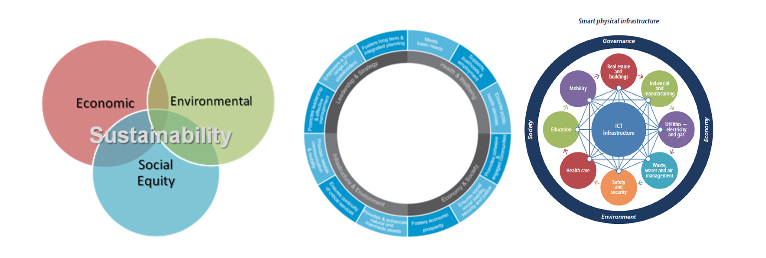
Sources: http://www.ci.neenah.wi.us/departments/sustainable-neenah-committee; http://www.100resilientcities.org/resilience#/-_/; https://itunews.itu.int/en/About.aspx
These three contemporary notions represent leading values of our time in the realm of city making. The three alternative models, however, share common objectives of
1) making materialistic progress with less social or environmental harm; and
2) maintaining a balance between three competing values – economic, social and environmental.
Differences are rather subtle and may be characterized as the following:
- Sustainable: Slow economic growth is allowed/tolerated/(possibly)preferred for the sustainability of the society and the environment.
- Resilient: Preparedness for (the future) challenges is highlighted and may come from various quarters (planning, leadership, etc.) but the economic power as the source of resilience is crucial. Resilient cities are more proactive than sustainable cities.
- Smart: Cities of this category might seek a third way of doing business to maximize materialistic prosperity and address all negative impacts on the non-materialistic values through some innovative, ‘smart’ means. It is as if they ask the question ‘is it possible at all not to compromise the materialistic potential while ensuring the protection of non-materialistic values? Smart cities might be most proactive and ambitious among the three notions of city.
Despite the similarities discussed earlier, the audience of the contemporary urban discourse seems to have their own perception about alternative notions, which are generally shared. For instance, cities such as Curitiba, Freiburg, Copenhagen and Mälmo are frequently cited with the sustainable label attached to them whereas a different set of cities such as Singapore, Seoul and Amsterdam are more often referred to as smart cities.
Nevertheless, it is quite clear that sustainability as a value and its practical implications are embodied in the smart city model. In other words, a city which is not environmentally or socially sustainable cannot make a smart city. Likewise, a city which is not resilient and unable to withstand external threats cannot be considered a smart city, or a sustainable city for that matter. Attempts to link resilience and sustainability have also been made, which may not be particularly inventive attempts given the objectives and values shared in large part between the two ideas (Asprone and Manfredi 2015).
After all, these three models represent the values and objectives that contemporary as well as future cities would aim to achieve. Given that the three share similar values and the objectives do overlap across the models, it might not be a fruitful exercise to discern amongst the models. The analysis above suggests that smart cities would entail the attributes of both sustainable and resilient cities and, in addition, is thought to cater for a more proactive approach to development. It might be sensible to take a more, albeit marginally, inclusive concept and ensure that all the core values subscribed by the three notions are well covered.
A glance at Seoul
“Korea has experienced remarkable success in combining rapid economic growth with significant reductions in poverty. Government of Korea policies resulted in real GDP growth averaging 10 percent annually between 1962 and 1994. …. Korea is the first former aid recipient to become a member of the Development Assistance Committee (DAC) of the Organization for Economic Cooperation and Development (OECD). …. Korea's experience in sustainable development, providing infrastructure and better services to improve the lives of the people, and its transition to a dynamic knowledge economy, provides lessons that can benefit many other developing countries (The World Bank 2015).”
As illustrated in this paragraph, the dramatic economic transformation Korea has achieved just in 50 years after the Korean War is relatively well known. What is less widely known is how it has been addressing the undesirable impacts of exceedingly rapid urban transition and equally rapid industrialization; how the country has exerted efforts in promoting spatial and social equity through, for instance, reducing regional disparity in development and the rural-urban differentials in terms of opportunities and the quality of life which accompanied the spectacular expansion of the wealth of the nation. In effect, Korea’s transformation has not been limited to the economic realm but extended to the other realms which are presently as much valued, including the environment and the society.
Clearly, Seoul has been the epicenter of all that transformation the country as a whole went through. As the greatest contributor to the nation’s economic growth, the city has undergone even faster growths in terms of population and activities and has therefore had a greater share of the impacts generated from rapid development. Just as the country has been making various attempts to address the consequences of rapid development, the city of Seoul has continually endeavored to deal with the undesirable outcomes of the extraordinary growth within an extremely short span of time. Years of such strenuous efforts have begun to show the signs of transformation for the previously quantity-driven, pro-development industrial city into a city that is now referred to as a smart city, or a city that crops up the list of exemplar cities in some specific senses such as a city with a smart transport system or superior e-governance system.
A few sets of statistics (Figure 2 – 4) below might give a sense about to what extent some of the acute urban problems most fast growing cities are faced with have been dealt with.
Figure 2. The share of sustainable transport modes in Seoul

Source: Seoul Metropolitan Government (2015)
Figure 3. Trends in the number of households and the number of housing units
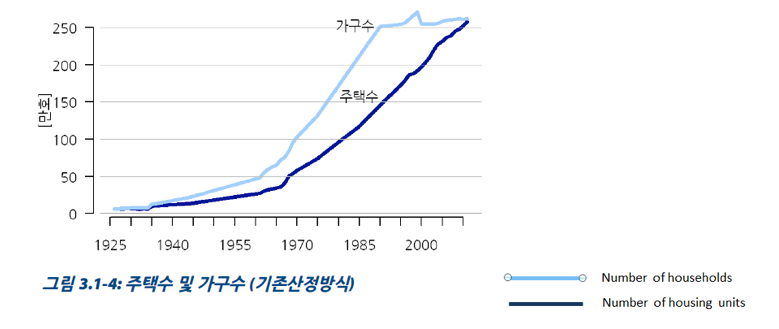
Source: Seoul Statistics Yearbook 2000, cited in Seoul Institute (2003)
Figure 5. Percentage of people recycling in selected cities, 2011
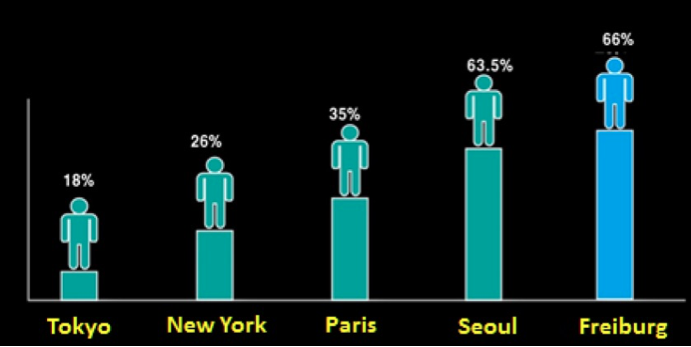
Size matters and so does speed: Dealing with mega-size urban problems in a short span of time
First, Seoul is quite different from other oft-cited sustainable or smart cities in terms of size. How many megacities in the world are also representative of the sustainable city? It is also one of the few sustainable or smart cities emerging from the developing world where it belonged to until not long ago. How many megacities which used to represent a city paying the price of hyper-urbanization and super-fast industrialization until about 20 years ago turned into one of the few cities representing highest rates of recycling in the world? All the recycling cities which appear in the previous illustration come from the traditional first world (or the countries which completed industrialization by the early 1960s) except Seoul.
Megacities are called as such because they exceed certain thresholds in terms of population size and for no other reasons – only that the threshold is something of a moving target as the cities in the world generally grew further and faster with time.
The difference in size means the scale of the problem is conspicuously different. It may help to be reminded of the quote that appeared at the start of this paper: “…megacities are inherently unsustainable, with their vast consumption of resources drawn from distant elsewheres, and equally vast production of wastes that are routinely exported elsewhere (Sorensen and Okata (2011).”
Figure 5 shows the size of growth in terms of urban population increment in Seoul over time. 270,000 people were added per annum (22,000 people per month) for 3 decades, from 1960 to 1990. The speeds of growth are also indicated as the slope of the curve.
Figure 5. Seoul’s population growth over time, 1920-2014
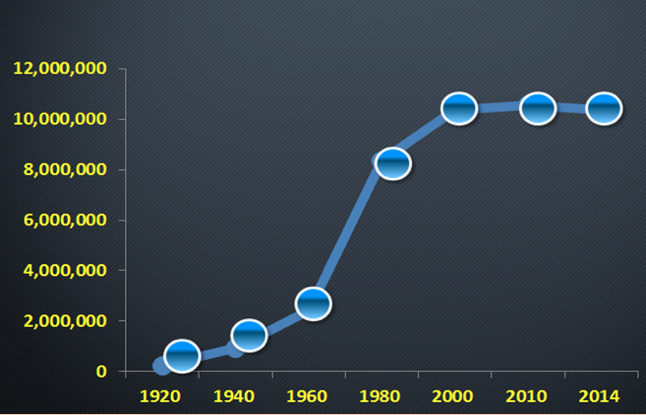
Source: Seoul Metropolitan Government
The size and rate of Seoul’s growth over the past century is compared with a few other world cities in Figure 6. Singapore, a city that is as often referred to as smart city is also included in the illustration. Seoul’s steep growths between 1960 and 1990 clearly stand out from the city group illustrated.
Figure 6. Population growth rates, 1900-2000, for selected cities
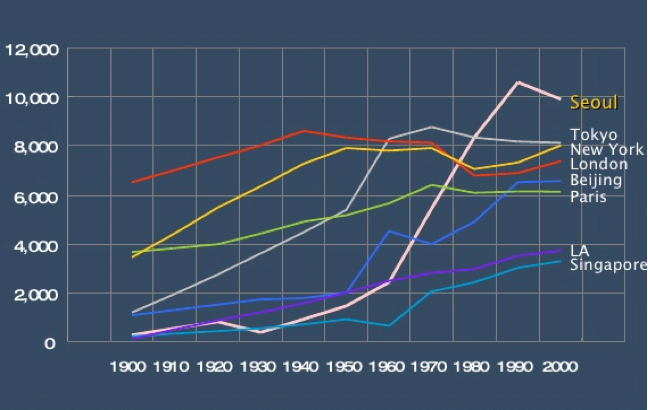
Source: Seoul Metropolitan Government
The rapid population growth in Seoul was paralleled by as rapid economic growths as Figure 7 indicates. Similar to the preceding comparison (Figure 6), the subsequent chart (Figure 8) highlights that the rates of economic growth in Korea have surpassed most other countries including some rapidly expanding economies in the developing world.
Figure 7. Economic growth rates in Seoul, 1960-2010
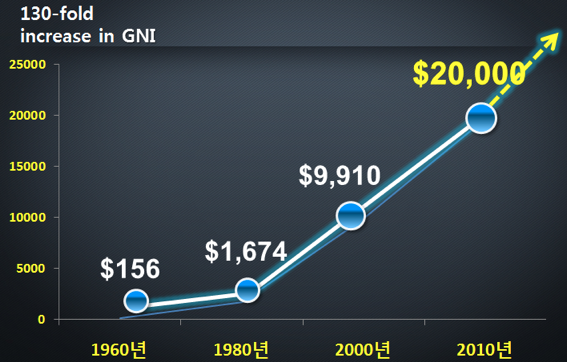
Source: Seoul Metropolitan Government
Figure 8. The rate of economic growths, 1961-2011, selected countries
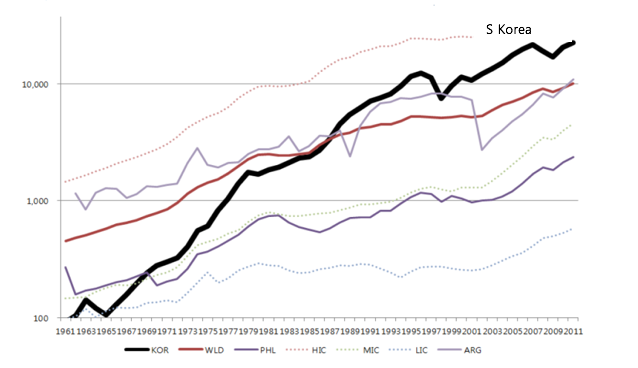
Source: The World Bank (2010)
These two sets of statistics well reflect how Korea and its primary city Seoul have undergone extremely compressed economic development, which did not leave much temporal room for urban planning that was needed to keep pace with the continued and rapid growth of the city. The space of time that was allowed to absorb the shock of rapid growth and deal with the consequences of fast-tracked growth was simply not sufficient.
As a matter of empirical fact, the time taken for industrialization has increasingly lessened over the centuries behind us as Figure 9 illustrates. It is not because newly industrializing countries have been more able than their predecessors but rather because of the much enlarged world market.
Figure 9. Time taken for industrialization for selected countries
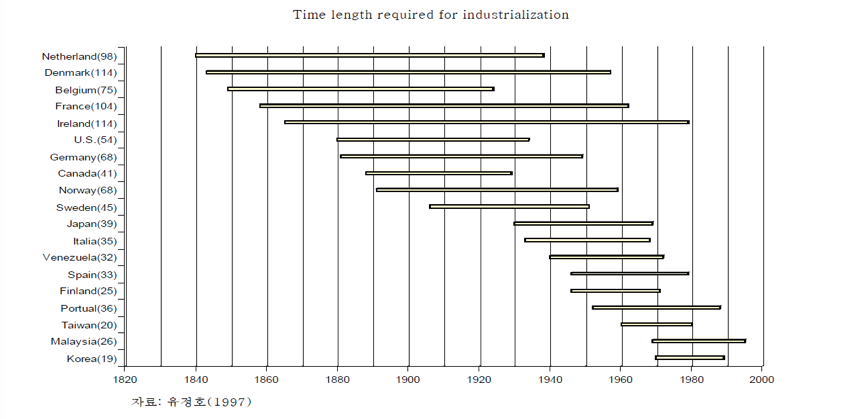
Source: Yoo (1997)
The successful urban management of Seoul ought to be looked at from this context of exceedingly rapid changes that occurred in the city. At such rates of growth, the magnitude of urban problems is normally overwhelming and, also, continues to grow at alarming rates in the absence of appropriate intervention, as have been seen in the numerous cases of megacities in the developing world. The following pair of illustrations (Figure 10 – 11) will give a flavor of how Seoul has been faced with some of the negative externalities of rapid urban expansion, most frequently associated with megacities.
Figure 10. Increases in the number of motorized vehicles in Seoul, 1958-1988

Source: Seoul Statistics Yearbook 2000, cited in Seoul Institute (2003)
Figure 11. Increases in waste generation in Seoul
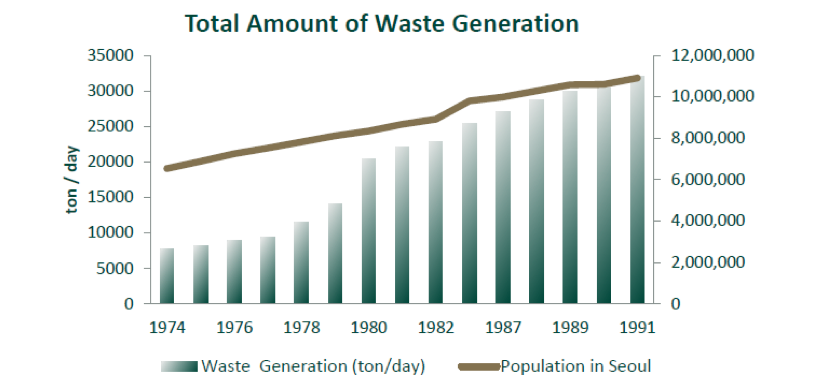
Source: Ministry of Environment cited in Seoulsolution 2014, Recycling (Smart Waste Management in Seoul)
Negative externalities are not necessarily proportional to population and economic growth
Figure 12. Ozone levels over time, Los Angeles
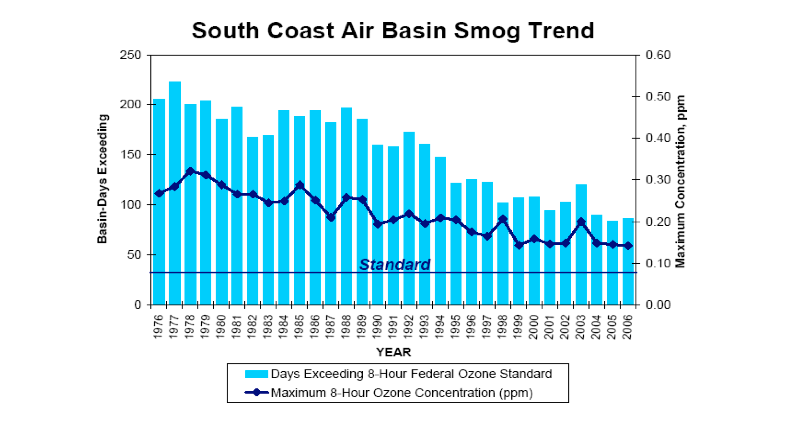
Source: South Coast Air Quality Management District (2007)
Trends in social costs of rapid growth in Seoul
Figure 13. Waste generation per person
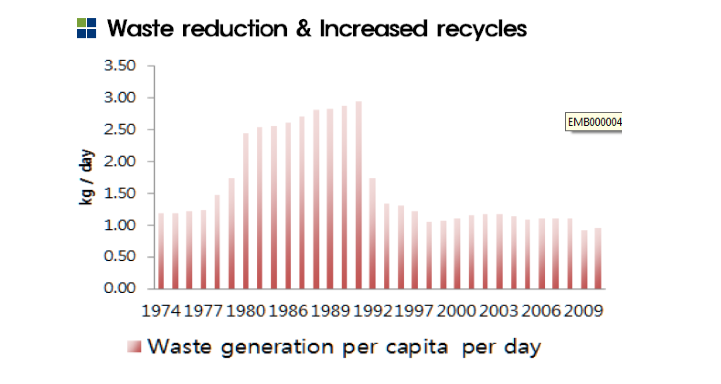
Source: Ministry of Environment, cited in Seoulsolution 2014, Recycling (Smart Waste Management in Seoul)
Figure 14. Transport-related emissions per person
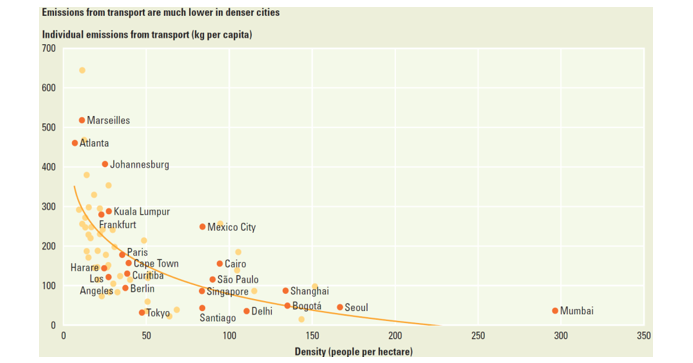
Source: World Bank 2009
Figure 15. Energy (road sector) consumption and GDP

Source: World Bank (2014)
Seoul is well known for a few flagship urban regeneration schemes such as Cheongyecheon Stream Recovery and Seonyoodo Park, both of which resulted in adding a significant amount of green space in the city. The former, in particular, has been selected as one of the few truly transformative urban schemes in notable research initiatives (Davis 2014). The overall increases in green areas in the city are summarized in the chart below (Figure 16).
Another area of focus in this regard is the building of green pedestrian network which is underway. This will connect the existing linear parks to Namsan, the city’s green lung with its central location and substantial presence.
Figure 16. Trends in the size of green areas (km2)
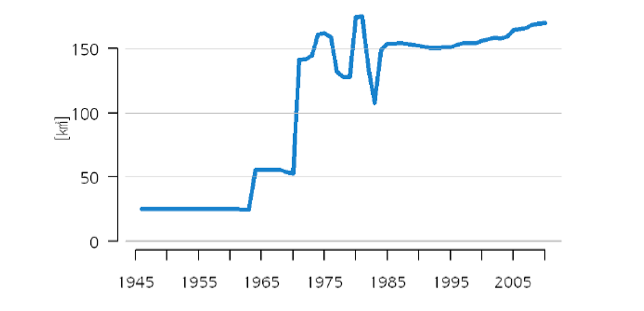
Source: Seoul Statistics Yearbook 2000, cited in Seoul Institute (2010)
Seoul is home to a 17% of the nation’s business establishments. In terms of gross regional domestic products (GRDP), the city accounts for about 23% of the nation’s economic outputs (Figure 17).
Figure 17. The intensity of economic activities in Seoul
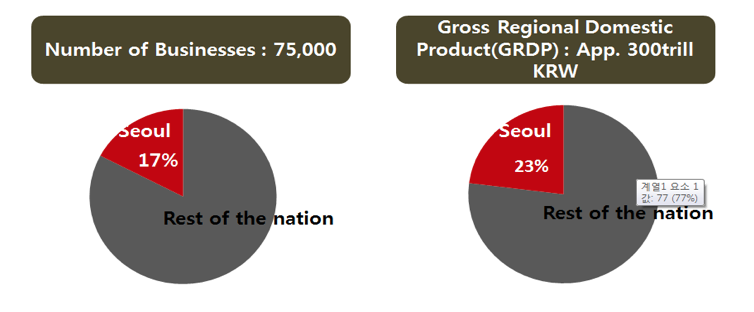
Source: Seoul Metropolitan Government 2015
Yet the country has managed to develop a relatively healthy urban hierarchy unlike some other countries with the presence of an overwhelming primate city, which is a trait often associated with developing countries (Figure 18).
 Figure 18. Korea’s economic density map
Figure 18. Korea’s economic density map
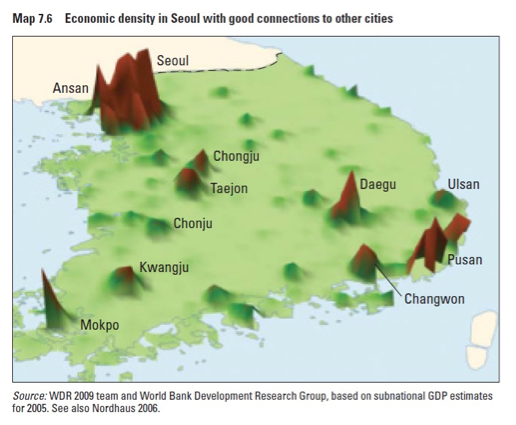
Source: World Bank (2009)
Korea, in the meanwhile, has shown a pattern of relatively strong growth for its income level as the following chart (Figure 19) suggests, whilst it is an accepted norm that the income levels and the income growth rates are inversely related.
Figure 19. GDP growth rates and income levels
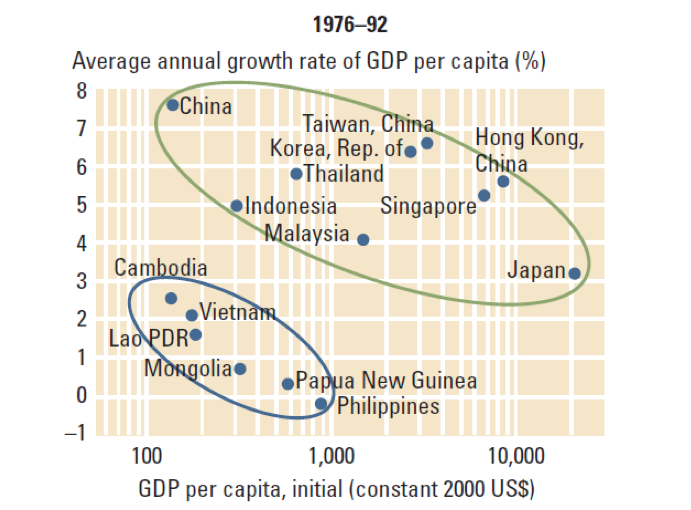
Source: World Bank (2007)
The trends in some of the urban problems in Seoul, such as waste generation, deficiencies in green or open space, pollutant emissions from motor vehicles, quite manifestly support the proposition that social costs, or negative externalities, are not necessarily proportional to the population or economic growth, as did the trends in urban air quality in Los Angeles. Rather successful management of the key urban problems in Seoul has been achieved while it continued to demonstrate a relatively strong sign of economic growth for its income level. Without suggesting that this would exactly fulfill the requirements for a smart city (and a definitive and well-established evaluation framework for smart city does not exist in any case), it is hard not to relate these trends in social costs to the key objectives of a smart city discussed earlier, that is ‘doing more with less’ and ‘growing with less social costs’.
What enabled the successful urban management in Seoul?
Is it the high density that made the smart transition possible? Indeed, Seoul’s urban density is among the highest in the world. The city has thousands of high-rise apartment buildings which house a very large segment of the residential population. This pattern of housing is followed up even in the new towns which were developed away from Seoul in an attempt to redistribute the city’s over-concentrated population. No doubt, the density contributes to the smart use of land and energy resources as two previous illustrations aptly demonstrate.
Or, is it the public resources which were available to the city that has been the key to the successful management of the city? Perhaps, the city did make smart use of what was available in terms of financial resources in building up the infrastructure it needed to accommodate its expanding populations and activities. Korea is known for its effective and well-established public investment management system, which means an equal amount of financial resources could well have resulted in a greater amount and quality of public infrastructure than in a country without such a system.
As such, both the urban densities and public resources (and their efficient use) have their places in the explanations for Seoul’s achievements in urban management. By any means, however, they are not the sufficient conditions for making a city smart as not all megacities with comparable, or even higher, densities (such as Manila) or megacities with comparable levels of resources (such as some Latin American cities) have shown similar trends in managing urban problems.
The explanations will inevitably have to be more complex than what can be fit in this brief discussion. Subsequent discussions, therefore, are to help explain the contexts, planning and implementation processes, governance, the political climate or the founding infrastructures, where relevant, in different policy domains.
What can be highlighted here is that Seoul’s success in urban management clearly exemplifies the ability, or even the power, of public policy as seen in the earlier example of Los Angeles. Seoul proactively and persistently implemented a set of policies addressing the key urban problems all rapid developers would be doomed to without appropriate intervention of some form. The secret also lies in selecting and prioritizing amongst competing needs and domains of policy, for public resources are finite regardless of the income level of the city. The selection was not dictated by some high moral values but by practical needs and implications. For instance, without smooth circulation of people and goods, the life of city residents and the city economy will suffer, if not come to an impasse, even if some other excellent policies seeking to promote equality in the city or the quality of local residents’ life are adopted and implemented. This probably is where Seoul was successful – at reaching a consensus in priority setting.
What has the city really done in practical terms? In a nutshell, the city developed a coherent and practical institutional framework that would ensure the implementation of the policy in question and the attainment of the policy goals for each policy area, often backed with comprehensive data of relevance, state-of-the-art technology and the best available knowledge sourced by teams of high quality researchers and officials and, where needed, streamlined the relevant institutional framework (even enacting special laws, if necessary).
While these policies were developed within a coherent strategic framework, each policy initiative was in fact developed as an individual building block. Initially, these were designed and implemented separately but when they were all completed at least in phases, they then made sense as a whole.
The highlights
Transport
Seoul’s transport system addresses the two most essential transport issues, which are accessibility and mobility. High degrees of accessibility have been achieved through one of the world’s most convenient public transport network that is within the reach of most local residents. Decent levels of mobility for the city’s size are provided through the balance between the extensive road network and the truly integrated transit the popularity of which ensures that the number of motor vehicles on the road is kept in check. Information and communication technology plays a significant role in the construction of Seoul’s smooth circulation and accessible transport, including the integrated monitoring system Seoul TOPIS (Transport Operation and Information System) and the ingenious development of night hour bus service network Night Owl Bus for which big data was used.
Another key component of the transport policy package include, amongst others, the 2004 Bus Reform, which enabled Seoul’s transit system to become truly integrated combining all four elements of transit integration which are service integration, fare integration, interchange facilities and information. A set of travel demand management measures is also in place and the built environment conducive to soft measures such as walking and cycling is under development both of which will contribute to guiding the travel behavior of citizens over a longer term.
E-governance
On numerous occasions, Seoul has been ranked first in terms of e-governance performance where it was assessed. The following table shows the results from an international research initiative on municipal e-governance (Table 1). The survey by Rutgers University identified Seoul as the best performer in various categories such as usability, service and citizen participation.
Table 1. Global e-Governance Survey Ranking
| Ranking | City | Score |
| 1 | Seoul | 84.74 |
| 2 | Prague | 72.84 |
| 3 | Hong Kong | 62.83 |
| 4 | New York | 61.1 |
| 5 | Singapore | 58.81 |
| 6 | Madrid | 57.41 |
| 7 | Vienna | 55.59 |
Source: Rutgers University 2009, cited in Choi 2014.
The construction of e-governance platform has taken a great deal of streamlining in the administration processes and data infrastructure building and maintenance work, but from the city’s perspective the expense is well worth it given the reward it receives in the form of citizen satisfaction and the external recognition which is a bonus contributing to civic pride. Seoul continues to advance its e-governance system seeking to achieve not just efficiency but also inclusivity by further enhancing transparency and accountability of municipal affairs.
Waterworks
Seoul has achieved a remarkable progress in waterworks both in terms of service provision, resource management and the quality of portable water through continued investment, policy development and implementation. This was a result from a long-run endeavor involving intensive investments in water production facilities upfront when the initiative took off about four decades ago, attempts at reducing water leakage through leakage restoration equipment as well as monitoring approaches, and more lately policies aiming to enhance the revenued water rates (RWR) and the quality of water again through a mix of investment and policies whilst renovating the now aging parts of the supply network. In a decade or so since the project to develop a reliable water supply network launched, the water service rate went up over 90% before it began to cover the entire city population. This all happened while the city continued to grow. In so doing, the city developed new financing mechanisms such as OECF loans, local bonds and foreign loans to address the funding challenges. Another factor contributing to consistent policy development and implementation has been the establishment of an independent agency in charge of governing the water in the city, Seoul Waterworks Authority, in 1989. Both the RWR and the water quality have been consistently showing an impressive uprising trend, respectively, reflecting the benefits of specialized management and institutional rearrangement.

Figure 20, Water supply rates in Seoul, 1960-2012

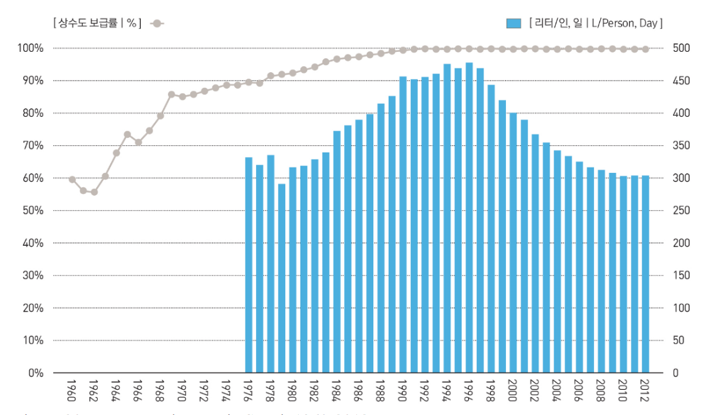
Source: Seoul Statistics
Figure 21. The number of water quality monitoring items and the turbidity of the treated water
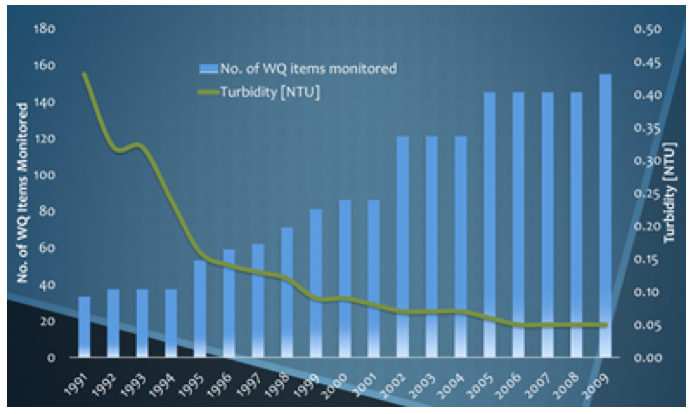
Waste Management
Waste management is another area Seoul has shown a transformative degree of progress, as has been illustrated in the earlier section. The changes were made possible through the implementation of numerous policies including volume-based waste fee system, restrictions on disposable products and excessive packaging, promotion of municipal recycling, creation of the market for second-handed goods, and the establishment of recycling centers and energy recovery system, among others. Figure 22 shows how the share of recycling has increased while that of landfill has decreased over time. Korea is the second-ranked country amongst OECD countries in terms of the rate of recycling, and

Seoul is leading the country in that regard.

Figure 22. Changes in waste generation and waste treatment methods, 1994-2011
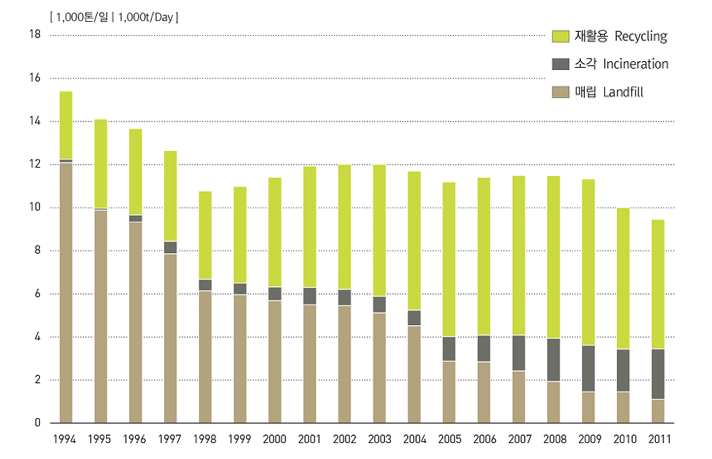
Source: Seoul Metropolitan Government 2016, https://seoulsolution.kr/ko/seoul-map
Transferability of the policy platforms
The year 2008 marked a point in time where for the first time over half of the world population began to live in cities. The proportion of urban population will increase to two thirds of the global population by 2050 – only 34 years later. Six out of 9.1 billion will live in cities. What is more striking is that a 95% of that urban expansion will take place in the developing countries.
Figure 20. Global urbanization projection
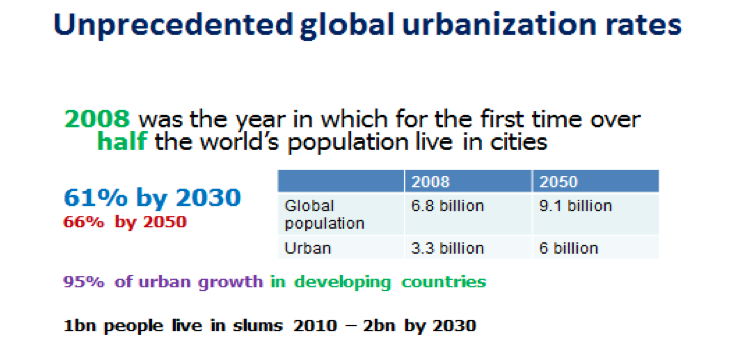
Source: UNHABITAT (2009)
These estimates suggest that many cities in the developing world will probably experience similar speeds of growth in population and economy, to those that Seoul was once faced with, over the next generation. This is why an increasing number of rapidly developing cities look to Seoul for possible lesson-drawing or policy emulation as they prepare to address a set of urban problems of similar intensities.
Concluding thoughts
It is not entirely clear whether it is primarily due to the ubiquitous technological applications in Seoul that the city has been referred to as a smart city. What Seoul has achieved is not limited to active application of advanced information technology in the area of city management as seen in this discussion. Indeed, Seoul uses technology, and information and communication technology in particular, to diagnose problems and prescribe solutions where needed but does not utterly rely on technology. Nevertheless, the successful implementation of Seoul’s urban policies is often associated with the effective use of data infrastructures which buttress and enable a systemic approach to urban solutions – in areas of land registry, waterworks, transport, safety, disaster, and so on.
In reflecting what made it possible for Seoul to build such a centralized system of urban data, one may question or even challenge the top-down approach that has been taken to build those systems of operation and monitoring.
Bottom-up, voluntary rules and political participation are all very well but in reality it is a question worth contemplating if super-rapid developers like South Korea can afford the time that is needed to form a voluntary consensus and then construct systems that work as efficiently as what Seoul has in place now. It is probably that the extent and the growth rates of negative externalities the megacity had to deal with were all too high for it to sit back and wait for agreements on every aspect of policy actions that it requires.
An overview of Seoul’s urban policies would reveal that a full array of policy approaches, ranging from the command-and-control type regulatory measures and market incentives/disincentives, to direct government investment and moral persuasion (Baumol and Oates 1988) have all been made good use of. It has taken the accommodationist’s approach (Banister 2003), supplying the basic infrastructures in response to the expanding demands, as well as demand management strategies to keep demand in check where needed. On the top of these classic policy typologies, it has also proactively made wise use of a highly innovative land delivery method to provide public infrastructure such as roads and parks – ‘land readjustment’ used only in a few countries in the world – as well as embraced other less conventional models of infrastructure investment/provision such as Public Private Partnerships (PPPs) and public corporations as an effective provider of public services. It is worth noting that the significant role played by the arm’s length quasi-public corporations such as Seoul Land and Housing Corporation (SH) is quite unique to Seoul, and Korea for that matter.
Figure 23 might depict how the city has strived to achieve the values subscribed by the citizens the contemporary global urban communities alike, including local economic well-being, sustainability, resilience and the quality of life. Illustrative policy responses and some of the key performance indicators seem to suggest that a large part of the urban investment was made in the area of infrastructure building. Whereas the infrastructures associated with the current discussion tended to focus on the physical and virtual infrastructures, due largely to the limited space and scope, the city underwent another set of compressed processes of developing and advancing social and institutional infrastructures. A wider and closer view will better illustrate how important it has been in Seoul’s express passage through development of late to build smart infrastructures in all four areas of physical, social, institutional and information.
Figure 23. Seoul’s approach to Smart and Sustainable Megacity
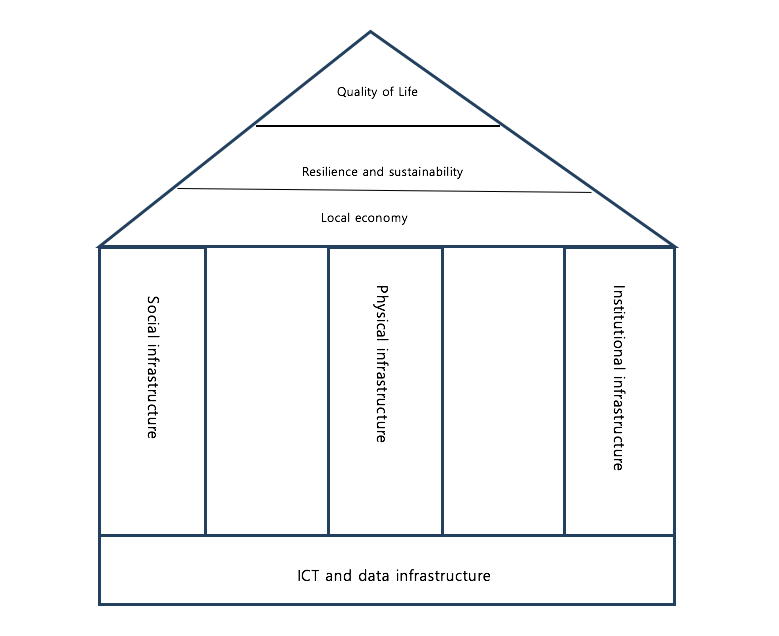
References
- Asprone, D. and Manfredi, G. (2015) “Linking disaster resilience and urban sustainability: a glocal approach for future cities,” Disasters 39(1), pp. 96–s111.
- Banister, D. (2003) Transport Planning: In the UK, USA and Europe. Routledge, New York, NY.
- Baumol, W. J. and Oates, W. E. (1988) The Theory of Environmental Policy. Cambridge University Press, Cambridge, UK.
- Choi, S. (2014) Seoul’s e-government towards a smart city, proceedings for Global Lab on Metropolitan Strategic Planning, Seoul Global Exchange, April 28 – May 1, 2014.
- Davis, Diane (2104) "Sustainable Infrastructure: the role of politics and governance", Public Lecture Series “Urban Infra Forum”, International School of Urban Sciences, The University of Seoul, July 10, 2014.
- Friedman, J (1986) “The World City Hypothesis,” Development and Change 17(1), pp. 69-83.
- Godschalk, D. (2003) “Urban hazard mitigation: creating resilient cities,” Natural Hazards Review 4(3), pp. 136-143.
- Gunderson, L.H., Holling, C.S., Light, S.S. (1995) Barriers broken and bridges built: a synthesis. In: Gunderson, L.H. (Ed.), Barriers and Bridges to the Renewal of Ecosystems and Institutions. Columbia University Press, New York, pp. 489–532.
- Holling, C.S. (1973) “Resilience and stability of ecological systems,” Annual Review of Ecological Systems 4, pp. 1-23
- Howard, E. (1902) Garden Cities of To-Morrow. Faber and Faber, London.
- Jacobs, J (1961) The Death and Life of Great American Cities. Random House, New York NY.
- Knox, P. L. and Taylor, P. J. (Eds.) (1995) World Cities in a World-system. Cambridge University Press, Cambridge, UK.
- Lo, F. and Yeung, Y. (1996) Emerging World Cities in Pacific Asia
- Mileti, D. (ed.) (1999) Disasters by design: A reassessment of natural hazards in the United States, Joseph Henry Press, Washington, D.C.
- Pickett, S.T.A, Cadenasso, M.L. and Grove, J.M.(2004) “Resilient cities: meaning, models, and metaphor for integrating the ecological, socio-economic, and planning realms,” Landscape and Urban Planning 69(4), pp. 369-384.
- Sassen, S. (1991) The Global City: New York, London, Tokyo. Princeton University Press, Princeton, NJ.
- Satterthwaite, D. (1997) Sustainable cities or cities that contribute to sustainable development? Urban Studies 24(10), pp. 1667-1691.
- Seoul Institute, Evolution of Seoul – an overview with indicators, https://www.si.re.kr/indicator accessed 13 February, 2015 (in Korean).
- Seoul Institute, Evolution of Seoul – an overview with indicators: Key statistics and trends (2010 Revision), The Seoul Institute, https://www.si.re.kr/indicator accessed 28 January 2014. (in Korean).
- Seoul Metropolitan Government (2000) Seoul Statistics Yearbook 2000, SMG, Seoul, S. Korea.
- Seoul Metropolitan Government, Seoul Solution – Seoul’s Urban Policy Archive, https://seoulsolution.kr/ accessed 2 February, 2015.
- Song, J. (2014) Smart Waste Management in Seoul: From Waste to Resource, proceedings for Global Lab on Metropolitan Strategic Planning, Seoul Global Exchange, April 28 – May 1, 2014.
- Sorensen, A. and Okata, J. (Eds.) (2011) Megacities – Urban Form, Governance, and Sustainability. sSUR-UT Series: Library for Sustainable Urban Regeneration 10, Springer, Tokyo, Dordrecht, Heidelberg, London, New York.
- South Coast Air Quality Management District (2007) Air Quality Management Plan, SCAQMD, Los Angeles, CA.
- The World Bank (2007) Development and the Next Generation, World Development Report 2007. The World Bank, Washington DC.
- The World Bank (2009) Reshaping Economic Geography, World Development Report 2009. The World Bank, Washington DC.
- The World Bank (2010) Development and Climate Change, World Development Report 2010. The World Bank, Washington DC.
- The World Bank (2015) The WB Country Profile http://www.worldbank.org/en/country/korea/overview, accessed 2 February, 2015.
- UNHABITAT (2014) A new strategy of sustainable neighbourhood planning: Five Principles, UN Habitat For A Better Urban Future Discussion Note 3 Urban Planning. Accessed 11 February, 2015 at http://unhabitat.org/wp-content/uploads/2014/05/5-Principles_web.pdf.
- Yoo, J (2014) Trade policy and economic development: The Korean experience, Public Lecture Series “Urban Infra Forum”, International School of Urban Sciences, The University of Seoul, December 11, 2014.